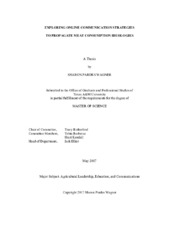| dc.description.abstract | Animals are raised for human consumption. This practice has become an increasingly divisive issue in America. On one side of this issue are those who believe that eating animals and using their byproducts is natural, normal, necessary, and nice; on the other are those believe consumption of animals is unnecessary and morally wrong. The purpose of this study was to explore how pro- and anti-meat consumption organizations communicate, reinforce, and advance their ideology online to actively shape public opinion. Online textual and visual strategies were examined, building on the foundational tenets of ELM, social identity theory, anti-consumption/reasons against, and inoculation theory. The homepages of three anti-meat organizations and three pro-meat organization websites were examined using a multi-phase content analysis that included critical discourse analysis, persuasive narratives, and semiotics strategies. Both qualitative and quantitative data was collected.
Input and output of animal production is contrasted on the pro- and anti-meat websites. Animal Rights Vegan Activists (ARVA) organizations portray animals as having souls, and are portrayed as equals to humans. Compassionate people are portrayed as those who expose the cruelty of using animals as a food source, and are vegan. Pursuit, rescue, and wretched excess plots are favored. Inoculations against lifestyle norms and values are favored. ARVA consistently portrays itself as an alternative societal lifestyle.
The meat organizations focus exclusively on food. Meat is quick, easy, affordable, and nutritious. Families want to eat it, and consumers feel good about serving it. Adventure, discovery, and maturation plots are favored. Inoculations against other meats, rather than against ARVA are present. Lifestyle norms and values, credibility, and information about meat appeared to be the inoculations favored. Rather than strengthening the universal brand of meat, the organizations actively subvert it through internal competition. Instead, pro-meat consumption organizations should promote their universal brand (i.e., meat) in a manner that not only resonates with the average consumer, but also encourages collective action by consumers in defense of the meat industry. | en |


